Hand-pulled noodles have always meant more to me than food—they’re part memory, part magic. I first fell in love with noodles in my grandmother’s Roman kitchen, watching dough stretch into silky ribbons. Years later, in a Tokyo ramen shop, I saw how this simple act—pulling noodles by hand—spoke across language and culture.
At Easy Noodle Recipes, I’ve made it my mission to explore and share these noodle traditions. This guide will walk you through the rich history, secrets, and step-by-step method for making authentic Chinese hand-pulled noodles right in your own kitchen.
What Are Hand-Pulled Noodles?
Hand-pulled noodles, known in Chinese as lamian (拉面), are a type of fresh wheat noodle made by stretching and folding dough into long strands using only the hands. This centuries-old technique originates from northwestern China and is as much a performance as it is a culinary skill—requiring a delicate balance of elasticity, strength, and rhythm.
Unlike machine-made noodles, hand-pulled ones offer a distinct chew and silky texture that’s hard to replicate. Each strand is unique, infused with the energy and intention of the person pulling it.
Lamian is often served in rich broths or stir-fried with bold sauces, but what makes it special is the handmade touch—something you can feel in every bite. Whether served in a bustling noodle house or made in your kitchen, it’s a dish that tells a story through its texture and tradition.
👩🍳 Hand-Pulled Noodles Recipe (La Mian)
Ingredients:
- 300g (2½ cups) all-purpose flour
- 150ml (½ cup + 2 tbsp) warm water
- 1 tsp salt
- 1 tsp neutral oil (optional)
- Extra flour for dusting
Step 1: Make the Dough
In a mixing bowl, combine the flour and salt. Slowly add warm water while stirring with chopsticks or a spoon. When the dough starts coming together, knead it by hand for 10–12 minutes until smooth. Add oil if using. Cover and let it rest for at least 2 hours.
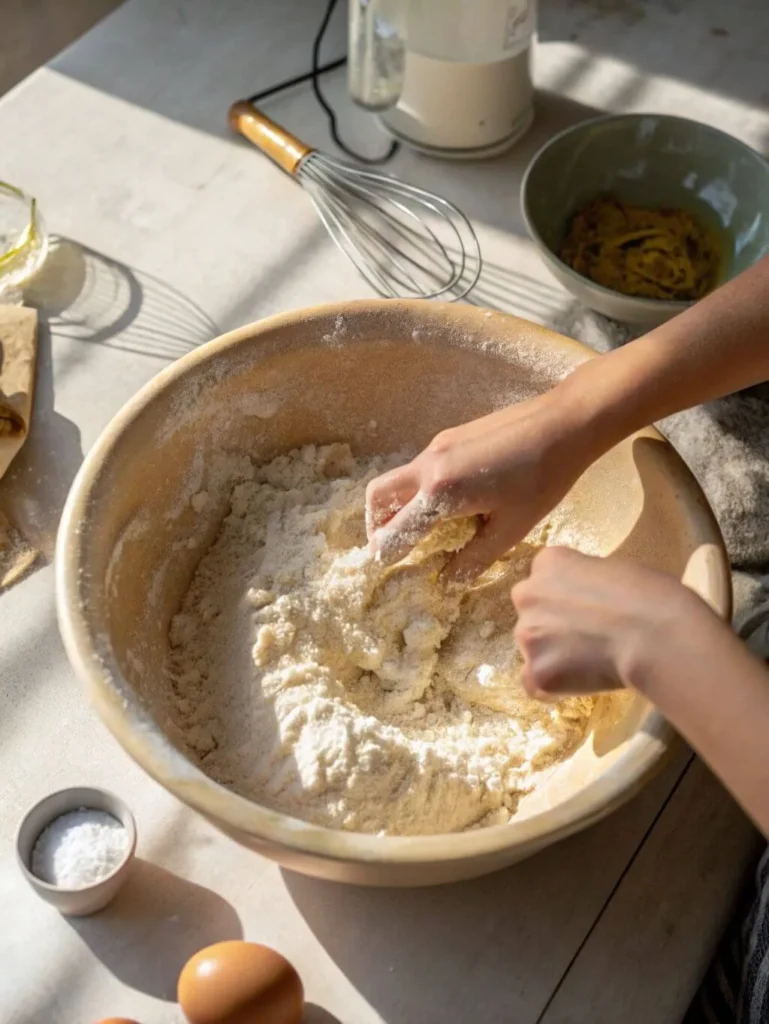
Step 2: Divide & Pre-Roll
Once rested, cut dough into 6 equal pieces. Roll each into a short log and coat with a little flour. Cover again and let rest for another 30 minutes. This second rest helps loosen the gluten for easy pulling.
Step 3: Pull and Stretch
Lightly oil your work surface. Take one dough log and flatten slightly. Gently pull from both ends, bouncing the dough off the counter in a rhythmic motion. Fold in half, twist, and stretch again. Repeat 3–4 times until the noodles are thin and even.

Pro Tip: If the dough resists, let it rest for 5 more minutes and try again.
Step 4: Cook and Serve
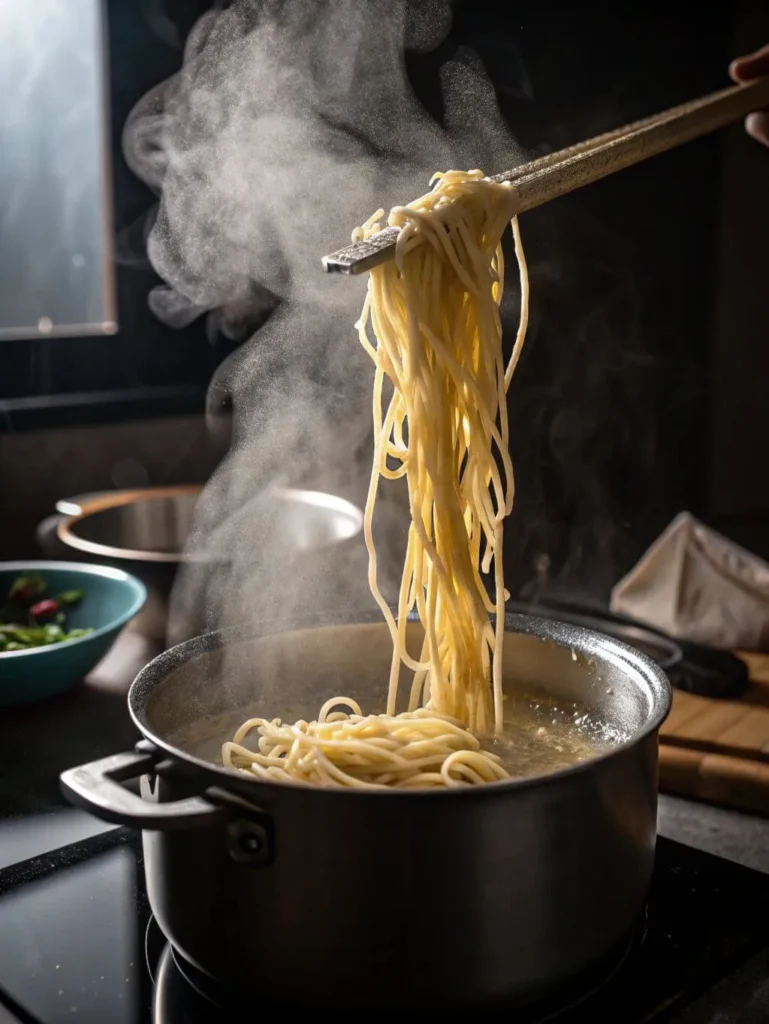
Drop pulled noodles into a pot of boiling salted water. Cook for 1–2 minutes until just tender but chewy. Drain and rinse briefly under cold water if stir-frying, or serve directly in soup or sauce.
🍲 Serving Suggestions:
- With rich beef broth and pickled mustard greens
- Tossed in chili oil and soy sauce for a spicy snack
- Stir-fried with vegetables and aromatics like garlic and scallions
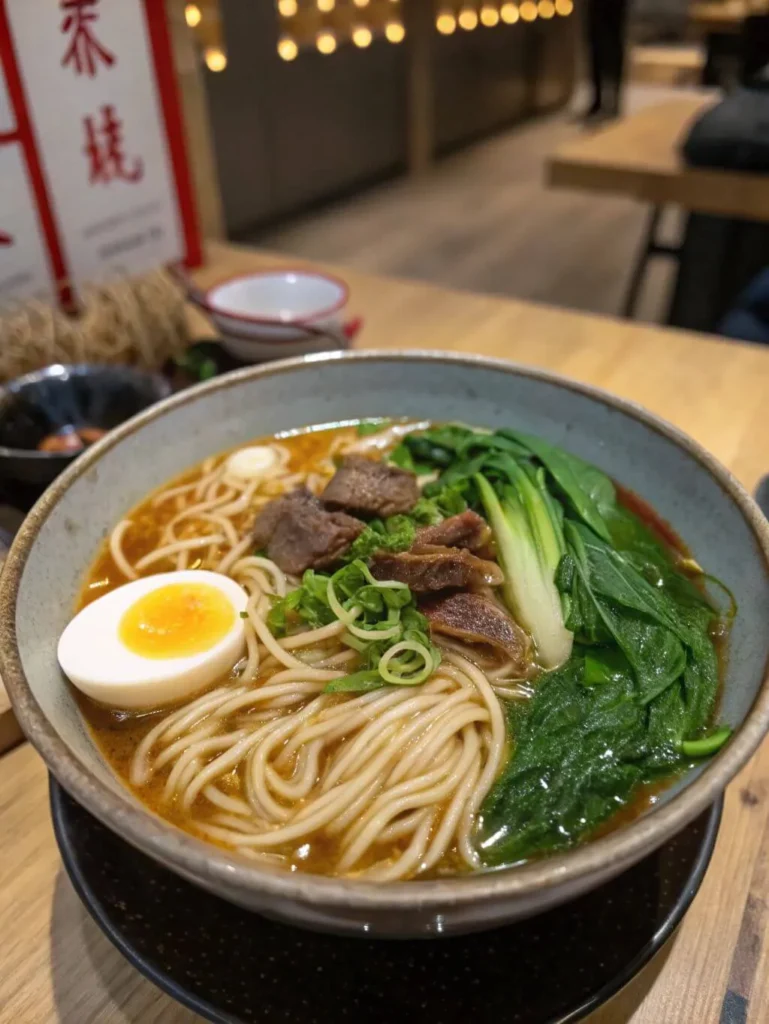
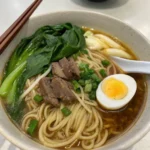
Hand-Pulled Noodles
- Total Time: 10 minutes
- Yield: 2 servings 1x
Description
Hand-pulled noodles have always meant more to me than food—they’re part memory, part magic. I first fell in love with noodles in my grandmother’s Roman kitchen, watching dough stretch into silky ribbons. Years later, in a Tokyo ramen shop, I saw how this simple act—pulling noodles by hand—spoke across language and culture.
Ingredients
-
- 300g (2½ cups) all-purpose flour
-
- 150ml (½ cup + 2 tbsp) warm water
-
- 1 tsp salt
-
- 1 tsp neutral oil (optional)
-
- Extra flour for dusting
Instructions
🥣 Step 1: Make the Dough
In a mixing bowl, combine the flour and salt. Slowly add warm water while stirring with chopsticks or a spoon. When the dough starts coming together, knead it by hand for 10–12 minutes until smooth. Add oil if using. Cover and let it rest for at least 2 hours.
🔁 Step 2: Divide & Pre-Roll
Once rested, cut dough into 6 equal pieces. Roll each into a short log and coat with a little flour. Cover again and let rest for another 30 minutes. This second rest helps loosen the gluten for easy pulling.
🌀 Step 3: Pull and Stretch
Lightly oil your work surface. Take one dough log and flatten slightly. Gently pull from both ends, bouncing the dough off the counter in a rhythmic motion. Fold in half, twist, and stretch again. Repeat 3–4 times until the noodles are thin and even.
✨ Pro Tip: If the dough resists, let it rest for 5 more minutes and try again.
🍜 Step 4: Cook and Serve
Drop pulled noodles into a pot of boiling salted water. Cook for 1–2 minutes until just tender but chewy. Drain and rinse briefly under cold water if stir-frying, or serve directly in soup or sauce.
🍲 Serving Suggestions:
-
- With rich beef broth and pickled mustard greens
-
- Tossed in chili oil and soy sauce for a spicy snack
-
- Stir-fried with vegetables and aromatics like garlic and scallions
Notes
Use frozen or fresh udon noodles for best texture. Customize with any veggies or protein you have on hand. Great for weeknight meals.
- Prep Time: 10 minutes
- Cook Time: 10 minutes
- Category: Dinner / Main
- Method: Stir-Fry
- Cuisine: Japanese
Nutrition
- Serving Size: 1 bowl
- Calories: 475 kcal
- Sugar: 4 g
- Sodium: 880 mg
- Fat: 18 g
- Saturated Fat: 4 g
- Unsaturated Fat: 12 g
- Trans Fat: 0 g
- Carbohydrates: 58 g
- Fiber: 4 g
- Protein: 18 g
- Cholesterol: 170 mg
Keywords: yaki udon noodles, Japanese stir-fry noodles, easy udon recipe
The Secret to Perfect Hand-Pulled Noodles
The beauty of hand-pulled noodles lies in their simplicity—but nailing that perfect stretch takes practice, patience, and a few pro tips. Here’s what makes or breaks your lamian experience:
1. Start with the Right Dough
The dough for hand-pulled noodles needs to be soft, hydrated, and elastic. Use all-purpose or high-gluten flour for optimal strength. A basic ratio is:
- 300g all-purpose flour
- 150ml warm water
- 1 tsp salt
- 1 tsp neutral oil (optional)
Salt helps strengthen the gluten, while a touch of oil adds stretch and a smoother texture.
2. Rest Is Not Optional
After kneading, let the dough rest for at least 2 hours—longer if possible for better texture. This allows the gluten to relax, making the dough more pliable and easier to work with. Cover tightly to prevent drying out.
3. Master the Pulling Motion
Divide your dough into strips, then gently stretch, twist, fold, and repeat. Don’t yank—pull with a rhythmic bounce, letting gravity and gluten do the work. You’ll double the strands with each fold until they reach your desired thinness.
4. Cook Immediately
Once pulled, boil your noodles right away in salted water for 1–2 minutes. Fresh hand-pulled noodles cook fast and are best eaten immediately while bouncy and tender.
Troubleshooting & FAQ
😣 Why are my hand-pulled noodles breaking?
This usually means the gluten hasn’t developed enough. Ensure your dough is kneaded thoroughly and rested properly (at least 2 hours). If it’s too dry, add a bit more water and knead again.
🧱 Why is my dough too tough to stretch?
Over-kneading or not resting long enough are common culprits. The dough needs to be soft and elastic—try letting it rest longer or adding a tiny splash of oil to improve flexibility.
🌀 My noodles are uneven—what am I doing wrong?
Uneven pulling often happens if your motion is jerky. Try a gentler, bouncy rhythm when stretching. Pull from the center outwards, keeping your hands equidistant for balance.
🍝 Can I store hand-pulled noodles?
Fresh hand-pulled noodles are best cooked right after pulling. If needed, dust with flour and refrigerate for a few hours. Avoid freezing—it affects texture.
🧪 Can I make the dough ahead of time?
Yes! You can refrigerate the dough overnight (wrapped tightly). Let it come to room temperature and rest again before pulling. Cold dough resists stretching.
👉 What is the difference between ramen and lamian?
Ramen is a Japanese noodle dish typically made with alkaline wheat noodles, often served in pork or miso-based broths. Lamian, or hand-pulled noodles, are Chinese in origin and made by stretching fresh dough into long strands. While both are wheat-based, lamian is handmade and has a chewier, silkier texture, whereas ramen noodles are machine-cut and springy due to kansui (alkaline water).
👉 What are Lamian noodles made of?
Lamian noodles are made with simple ingredients: wheat flour, water, salt, and sometimes a small amount of oil. The magic lies in the dough’s elasticity, achieved through resting and kneading, which allows it to stretch without breaking.
👉 What is the secret of hand-pulled noodles?
The secret to hand-pulled noodles is all in the dough. It must be soft, well-hydrated, and rested enough to become elastic. Proper gluten development allows it to stretch into long, uniform strands. Technique also matters—pulling in a rhythmic motion ensures even thickness and texture.
🍽️ More Noodle Recipes You’ll Love
If you enjoyed making hand-pulled noodles, here are more recipes and noodle guides from Easy Noodle Recipes to keep the slurping going:
- 🧠 How Noodles Conquered the World – A flavorful history of how noodles traveled across cultures.
- 🍝 Homemade Noodles Recipe – A beginner-friendly guide to making noodles from scratch.
- 🥢 Lo Mein Noodles – Fast, easy, and packed with umami.
- 🍜 Ramen Noodle Recipes – Explore Japan’s favorite noodle bowl.
- 🌾 Shirataki Noodles – A low-carb noodle alternative worth trying.
- 🍝 Fettuccine Alfredo Recipe – Creamy comfort food at its finest.
- 🍝 Easy Spaghetti Recipe – Perfect for busy weeknights.
- 🌿 Angel Hair Pasta Recipe – Light, quick, and elegant.
- 🍲 Chinese Chow Mein – Stir-fried satisfaction in every bite.
- 🍝 Homemade Pappardelle – Wide noodles, bold flavors.
- 🍜 Yaki Udon Noodles – Thick noodles, stir-fried to perfection.
- 🍜 Noodle Types and Varieties – A full guide to choosing your next favorite noodle.

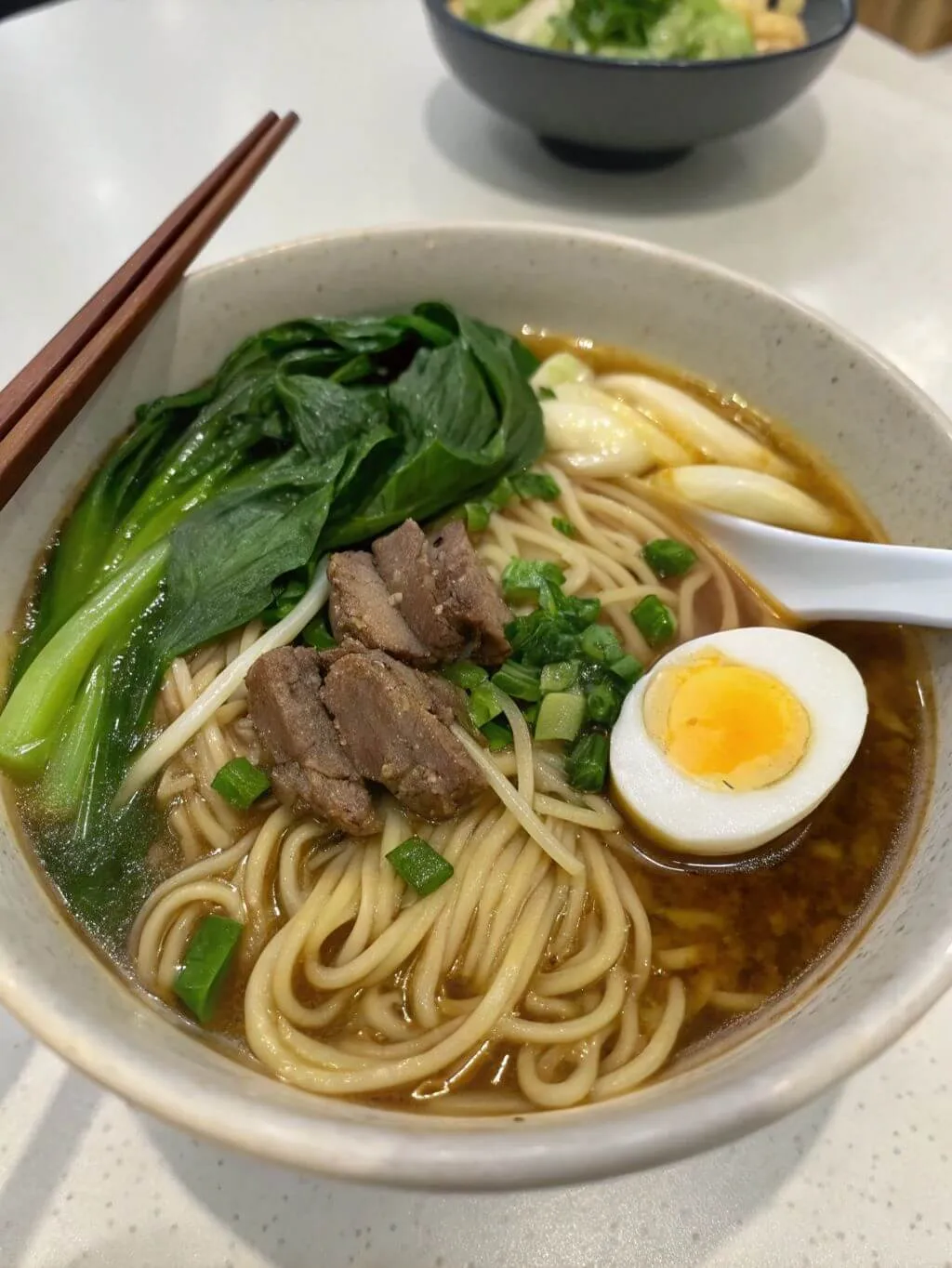
4 thoughts on “Hand-Pulled Noodles: The Ancient Art That Stretches Across Cultures”